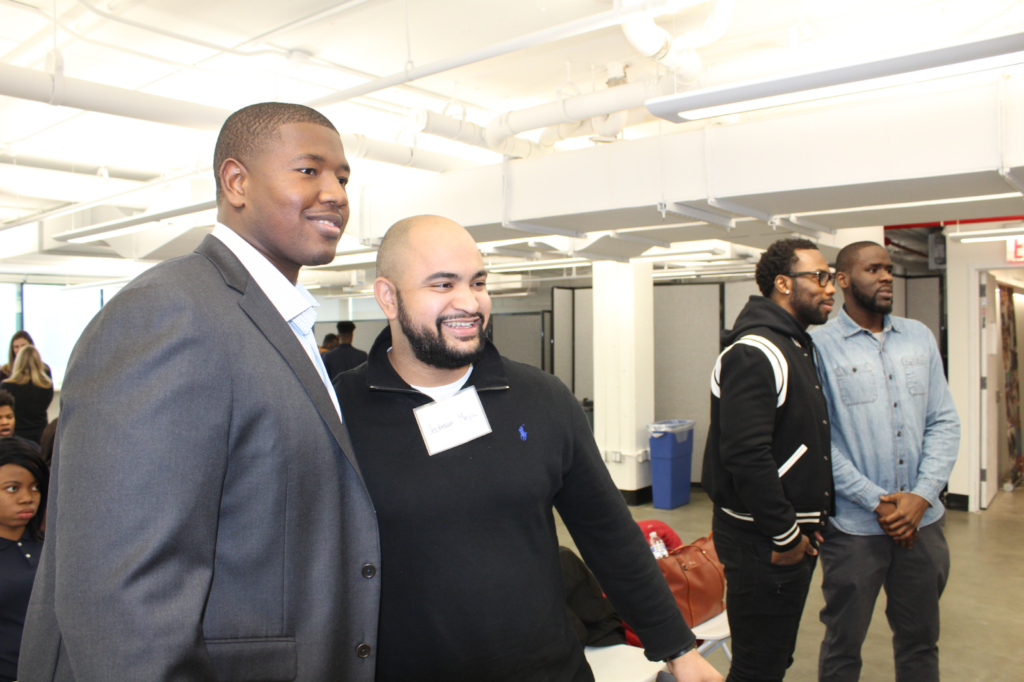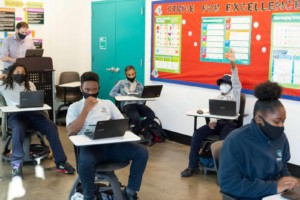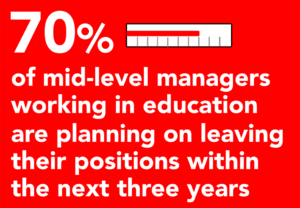Equity and ESSER: Why Now is the Perfect Time for Schools to Invest in Educator Diversity
Key Points
-
Research shows that representation is important as the increased exposure to educators of color correlates directly with students’ ability to visualize and manifest themselves into higher career opportunities.
-
By deepening their partnership with educator-preparation programs, school districts can better serve students and strengthen their workforce.
-
Schools can and should use federal funds to create long-term solutions to staffing shortages and create a more diverse workforce that reflects the communities they serve.

By: Erin Mote, Kate Cochran, Chuck Jones and Eric Tucker
Staffing shortages are straining school communities around the country, even as new variants of COVID-19 make the pathway forward uncertain.
Schools can use federal funds to create long-term solutions to staffing shortages and create a more diverse workforce that reflects the communities they serve. Key steps:
- Build partnerships with local community colleges and four-year colleges and universities
- Pay teachers-to-be during their training year in the classroom
- Consider student loan forgiveness
- Create incentives for support staff, including tutors and aides, to become fully credentialed teachers
These are challenging times for education leaders everywhere. But amid the hardships and turmoil associated with the pandemic is a chance to make real progress toward achieving a long-standing goal for public education: building an educator workforce that better reflects the diversity of the students schools serve.
Using new funding resources and an opportunity to “reset” school priorities, educators are finding creative, ambitious ways to hire more teachers and other school staff who reflect the communities they serve. That means hiring, supporting, and retaining more teachers and staff of color, whose lived experiences mirror those of the students and families they serve.
“There are so many initiatives right now that are opening the door for a more diverse workforce,” said Monica Martinez, director of strategic initiatives at the Learning Policy Institute. “We’re seeing a momentum shift. … I feel very hopeful about the work that’s being done right now.”
The K-12 student population is more racially diverse than ever before, with Latino students comprising almost 25% of the student population (up from 18% a decade ago) and Black students making up 15%. Asian students represent 6%, and white students 59%, according to U.S. Department of Education data. Some states are even more diverse. In California, for example, non-white students represent well over 75% of the K-12 student enrollment.
But teachers in every state remain overwhelmingly white, according to a 2020 survey by the U.S. Department of Education. Nearly 80% of public school teachers are white, fewer than 7% of teachers are Black, and just 2% are Black men. This indicates that representation is often not considered in the design of school systems.
But research shows that representation is important as the increased exposure to educators of color correlates directly with students’ ability to visualize and manifest themselves into higher career opportunities. According to the Brookings Institute, Black and brown students scored higher on standardized tests, had higher attendance rates and were less likely to be suspended when they had at least one teacher who matched their race.
Investing in educators of color allows us as a sector (both charter and public, and private) to consider the natural deposit of development and sustainability for the families we serve. Using funds from the Every Student Succeeds Act and American Rescue Plan, schools are now in a unique position to bolster the diversity of their workforces and invest in long-term staffing solutions.

The key, according to some of the country’s leading experts on the issue, is partnerships – not just with local colleges and universities, but with organizations that can help schools create permanent teacher pipelines.
“This is not easy work. You’ll get further down the road if you engage with an external partner who’s has experience supporting this kind of work,” said Karen DeMoss, executive director of Prepared to Teach at the Bank Street College of Education. “We’ve seen the bumps, and we know how to get around them.”
DeMoss urges schools to expand co-teaching and residency opportunities, which can make teaching a more accessible and appealing career for everyone, especially people of color.
Grow Your Own (GYO) is an educator preparation strategy that focuses on recruiting, developing, and retaining teachers from the local community. GYO models have been effective in both urban and rural areas in addressing shortages and increasing educator diversity, as highlighted in New America’s resource.
Co-teaching allows a novice teacher, or one who’s still in a training program, to share a classroom with an experienced teacher who can serve as a mentor. The advantages are myriad, she said, as the experienced teacher can get some extra help in the classroom and the newer teacher can gain on-the-ground experience from a seasoned veteran. If done well, co-teaching can:
- Reduce discipline referrals, which disproportionately impact student of color
- Reduce the need for remediation, as students can get more individualized attention
- Improve early intervention for students with disabilities, helping students get the help they need sooner.
Paying teachers for their residencies is also a good way to bring in more teachers of color, she said.
“Most people cannot afford to learn to teach for free, for a whole year. This is not a democratic system of access. And it’s clearly not equitable for students,” DeMoss said, noting that under-prepared teachers are more likely to work in high-needs schools.
Education leaders who balk at paying teachers for their residencies should consider the high cost of teacher turnover, she said. Each time a teacher quits, districts lose an estimated $20,000 in time spent on on-boarding and off-boarding. Instead, schools should put that money toward a system that pays residents a fair wage and retains them over the long term. Funds set aside for professional development can also be used for residencies.
Research shows that representation is important as the increased exposure to educators of color correlates directly with students’ ability to visualize and manifest themselves into higher career opportunities.
Eric Tucker
The Learning Policy Institute’s report, Diversifying the Teaching Profession: How to Recruit and Retain Teachers of Color, describes research on alternative certification routes that do not provide comprehensive preparation and resulting turnover rates among teachers of color.
“Remember, you’re retaining these teachers, so you’ll need fewer of them over the long term,” DeMoss said. “This allows you to have a high-impact teacher preparation program in your district that’s sustainably funded.”
Lisa Thomas, senior education policy analyst at the American Federation of Teachers, said education leaders should look to support staff as a source of teacher diversity. Paraprofessionals, aides and others on campus “already have the experience. They just need the credentials and the pedagogy,” she said. “There’s a real opportunity there.”
Investing in support staff’s professional development is also a great way to demonstrate how much those staff members are valued, she said.
“The pandemic has shown us how important and how essential and how critical the support staff is – our paraprofessionals, our bus drivers, our cafeteria workers, and everyone else that make up the support network in our schools.”
Brent Maddin, executive director of Next Education Workforce at the Arizona State University Teachers College, also urged education leaders to create career pathways for paraprofessionals. He suggested providing them with specialized training, such as in early literacy, and offering them pay raises as an incentive.

According to Maddin, paying teacher residents – with special priority given to Pell grant recipients and first-generation college students – is also a great way to attract people of color and those from low-income backgrounds to the teaching profession.
“When we think about equity, we need to think about the amount of debt undergraduates carry when they leave our universities,” he said. “We need to ask ourselves, are there things we can do to create more paid residencies? That can make a big difference.”
Partnering with local community colleges and four-year colleges and universities is a key way for districts to create a pipeline for diverse community members to become teachers. Loan forgiveness and pay for teaching residents are good ways to attract a wider variety of candidates to the teaching profession, Martinez said.
But diversity efforts should not be limited to teaching staff, she added.
What students especially need right now is extra support on campus – tutors, aides, mentors and extended learning staff who can help students with pandemic-related learning loss and overall school engagement.
Districts should use their ESSER and ARP funds to boost support services, bringing more high-quality assistance to students who need it.

“This is not an argument about reducing class sizes. This is an argument for providing extra support for students,” Martinez said. “It’s about prioritizing wellness and accelerated learning. It’s about evidence-based practices for tutoring and mentoring. … All of our kids are in a different place right now. No two will have had the same experience, and they need all the support we can provide.”
Patrick Steck, senior director for policy at Deans for Impact, echoed Martinez’s support for hiring high-quality tutors, especially in high-needs schools, and then encouraging them to become fully credentialed teachers.
“Mobilizing future teachers as tutors – especially at the district’s highest-need and hardest-to-staff campuses — holds great promise for strengthening partnerships between institutions of higher learning, school districts, and the broader community,” he said.
To do this, districts should strengthen and formalize their ties to local colleges and universities, so future teachers have a seamless transition from their preparation programs to employment.
The benefits are many:
- Institutions of higher learning can fulfill their missions to serve the local community
- College faculty can offer future teachers more access to high-quality classroom experiences
- Future teachers can strengthen their instructional skills, fulfill licensure requirements, and, in many cases, earn compensation
- School leaders build a sustainable pipeline of highly effective teachers that are likely to understand and stay in their communities
- Families gain a valuable addition to their support network
- Students gain access to additional academic and social-emotional support.
“By deepening their partnership with educator-preparation programs, school districts can better serve students and strengthen their workforce,” he said. “With deeper partnerships, everyone benefits.”
Erin Mote is the co-founder of Brooklyn LAB and CEO of the non-profit InnovateEDU. You can reach Erin at @erinmote.
Kate Cochran is Chief of Staff at the non-profit InnovateEDU.
Chuck Jones is Middle School Director at Brooklyn LAB.
Eric Tucker is the co-founder and Executive Director of Brooklyn Laboratory Charter Schools.
Guest Author

Eric Tucker







0 Comments
Leave a Comment
Your email address will not be published. All fields are required.